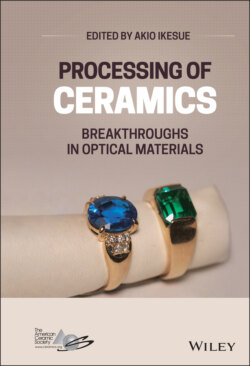Читать книгу Processing of Ceramics - Группа авторов - Страница 24
2.3.3 Synthesis and Laser Performance of Sesquioxide Ceramics
ОглавлениеSesquioxide has been attracting attention as a promising laser host. For example, in the case of Y2O3, since the melting point is above 2400 °C, the Bridgman method requires a crucible such as Re (rhenium). In addition, at around 2200 °C after solidification, distortion, and cracks occur inside the material due to a volume change accompanying the transition from hexagonal crystal system to the cubic crystal system. It is impossible to produce a high‐quality single crystal by the conventional melt solidification method. The author himself has ever tried to produce a Y2O3‐Tb2O3‐based single crystal material by the FZ method. As shown in Figure 2.9, a solid substance (crystal) is formed but when it is analyzed with EBD (electron‐beam diffraction), the second phase is also formed in the produced crystal. It was not possible to synthesize an optically isotropic and homogeneous substance.
If the sesquioxide ceramic materials can be synthesized at a temperature below the phase transition point and a low temperature, problems unique to this material can be solved. In the 1980s, Tsukuda et al. attempted to synthesize transparent Y2O3 ceramics, but the grain size was very large, and it only showed a slight translucency. In 1974, Greskovich succeeded in synthesizing Nd:10%ThO2‐Y2O3 ceramics and also pulsed laser oscillation at room temperature but lasing efficiency was about 0.1%. After this achievement, quality improvement was performed but there has been no significant progress at all. Since a large amount (10%) of radioactive ThO2 was added as a sintering aid in this material, a large amount of secondary phase (precipitates = scattering source) named as “orange peel” generated. For this reason, optical distortion in the material caused by the “orange peels” becomes significant, and the broadening of absorption and emission spectrum occurs. Also, a large amount of point defects is appeared as Th4+ replacing Y3+ in the host material (Y2O3), and it adversely affected the laser characteristics. Therefore, (i) low‐temperature synthesis, and (ii) lower amount of sintering aid are the keyword for the synthesis of sesquioxide ceramics.
Figure 2.8 (a) Schematic diagram for a mode‐locked system. Source: Reprinted with permission from [10], copyright 2004, American Institute of Physics. (b) Laser performance under CW operation and (c) spectrum for the shortest pulse generation with 0.5% output coupler for 15% Yb:YSAG ceramic. The solid line indicates the ideal sech2 shape.
Source: Saikawa et al. [10].
Figure 2.9 Appearance of Y2O3‐Tb2O3 (including Tb4+ ions) single crystal by floating zone method and analysis results by EBD (electron‐beam diffraction).
Figure 2.10 shows a flow sheet for a synthesis example of sesquioxide ceramics (Nd:Y2O3). Nanosize Y2O3 and submicron Nd2O3 powder were used as starting materials, and a small amount (0.2–0.5%) of ZrO2 (particle size 30 nm) was used as a sintering aid. (The sintering aid ZrO2 suppresses the grain growth of the sintered body in the process of sintering, and the ceramics obtained by adding the sintering aid can be improved to optical grade.) Raw powder materials, sintering aids, a dispersant, a binder, and an appropriate amount of ethyl alcohol solvent were mixed in a pot mill for 10–20 hours. The obtained slurry was spray‐dried by a spray dryer to prepare spherical granules. The prepared powder granules were uniaxially pressed in a metal mold, and then pressed by CIP (cold isostatic press) machine at 146 MPa and calcined at 800 °C for three hours in order to decompose the organic components in the molded green powder compact. Then, it was sintered at 1500–1600 °C under vacuum and then subjected to HIP treatment at 1550–1650 °C with 98–176 MPa (Ar gas pressure) to obtain a transparent ceramic material.
Figure 2.10 Fabrication flow sheet of transparent Nd‐doped Y2O3 ceramics.
Figure 2.11 Appearance of Nd‐ and Yb‐doped Y2O3, and Tm‐ and Er‐doped Lu2O3 ceramics.
Figure 2.11 is a photograph of the appearance of Nd‐doped Y2O3 and Yb‐doped Lu2O3 ceramics produced by the author. Both materials show high transmission characteristics (transmission loss less than 0.5%/cm). Since serious development of this material just started from this century, the optical quality is rather inferior to the garnet type material, but the problems of this material intrinsic to the single crystal material are solved.
Figure 2.12a–c shows the appearance of undoped Y2O3 ceramics (Ф160 × t10 mm), Schlieren image and the transmittance of this material, respectively. The obtained ceramics show high light transmission characteristics and homogeneity, and it is also possible to increase the material size which cannot be realized by the conventional single‐crystal synthesis method. It is also possible to synthesize a large‐sized laser gain medium in which a laser‐active element such as Nd, Yb, Er, etc. is doped, and in the future, it can be used as a high‐power laser light source.
Figure 2.12 (a) External view, (b) Schlieren, and (c) transmission spectrum of large‐sized undoped Y2O3 ceramics.
Rare earth oxides such as Sc2O3, Y2O3, and Lu2O3 are promising laser materials, but it is difficult to synthesize these single crystals by the conventional melt growth method because the melting point is around 2400 °C, and it has a phase transition point just below the melting point. Ceramics can be synthesized at 1500–1700 °C, which is much lower than the melting point, so that the technical issues in the conventional methods can be solved. Figure 2.13a shows the absorption and emission spectrum of Er:Sc2O3 ceramics and its external appearance [11]. Schematic setup of laser oscillator using cryostat cooling system is shown in Figure 2.13b. Laser oscillation performance at 1.5 μm using the Er:Sc2O3 ceramics is shown in Figure 2.13c, and a very high laser oscillation efficiency was obtained.
